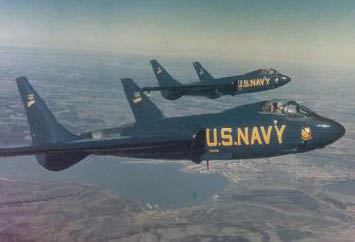


Aircraft of the Month for December 1999
Chance Vought F7U Cutlass

Photo Courtesy of National Museum Of Naval Aviation




 History
History
In 1945 the USN issued a request for a high performance jet fighter, capable of speeds of 970 km/h (515 kts/600mph) and able
to reach altitudes of 12200 m (40000 ft). Chance Vought won the contract in June 1946. The new fighter was described by the
Navy as an "experimental, tail less fighter designed for carrier operations and equipped with two 24C turbojet engines."
The design featured swept wings, tricycle landing gear, a pressurized cockpit, and four twenty millimeter cannons.
The requests for the four cannon and the tricycle landing gear were radically new; in 1946, very few aircraft a nose wheel.
Most aircraft still had a tail wheel, straight wings and were unpressurized. Much of the technology used in this new design
evolved from allied technical evaluations of German aircraft following World War II.
The F7U was the first USN aircraft designed with swept wings. Its delta wing featured radically different
control surfaces than any seen before. Ailerons joined with horizontal stabilizers to form "elevons." The F7U featured twin
tails and rudders. Since the tailless design demanded a critical center of gravity, an unusually long nose strut was applied
to the aircraft to give it a very high angle of attack during takeoff and landing. However, the unusual design produced
the highest roll rate of any of the USN's jets - up to 576 degrees a second! Also, the pilot was provided with a ejection
seat and a pressurized cockpit.
The F7U was designed for more powerful engines than it ever reveived, and the afterburning Westinghouse J34-WE-32 jet engines,
which were installed in the side by side in the read fuselage and which powered the prototype, didn't provide enough power to
make the F7U safe to fly. The design was quickly changed to use the more powerful J46 jet engines. Although the F7U-3 version
first flew in December 1951, a lack of J46 engines kept the first F7U-3's from reaching service until fall, 1954. Even the
initially promising J46 design proved a disappointment - the J46 design promised 10,000 lb in afterburner, but in reality the
thrust was less than half that. The J46's also had a very high maintenance to flight time ratio and they wore out quickly,
which meant a lot of maintenance time for the aircraft; but altering the design again to adapt to more powerful engines was
out of the question - Turbojet technology was evolving too quickly for airframe designers to keep up.
The Blue Angles received two F7U-1's, which they only used in the 1951 season. The F7U's new pressurized hydraulic system
was unreliable, and if it went out, it took 11 seconds for the manual override to activate. This made airshows dangerous.
During 1955, production was canceled in favor of the newer and far superior F8U Crusader, also made by Vought and still
used today by France.
F7U-3s equipped 13 fleet squadrons, four test squadrons, and one reserve attack squadron, VA-212 at NAS Moffett Field,
California. The "Rampant Raiders" of VA-212 made a six month cruise aboard the carrier "Bonne Homme Richard", returned early
in 1957, and traded their "Cutlasses" in for F9F-8 "Cougars." One VA-212 "Cutlass" survives today, restored and on static
display at the US Navy's National Museum of Naval Aviation in Pensacola, Florida. The Marines operated only two F7U-3's from
NAS Miami, now Coast Guard Air Station, Opalocka.


Chance Vought F7U Specifications
| ||
|---|---|---|
| F7U-1 | F7U-3 | |
| Type | ||
| Powerplant | Two Westinghouse J34-WE-32 turbojets | Two Westinghouse J34-WE-8A turbojets, 4600 lb thrust each |
| Accommodation | ||
| Armament |
| |
| Performance | ||
| Max speed | ||
| Combat radius | ||
| Ceiling | ||
| Climb Rate | ||
| Weights | ||
| Empty | ||
| MTOW | ||
| Dimensions | ||
| Wingspan | ||
| Length | ||
| Height | ||
| Wing Area | ||